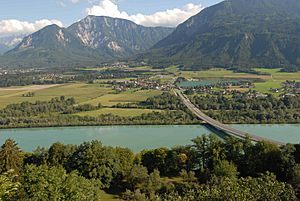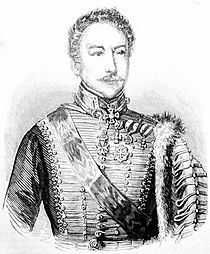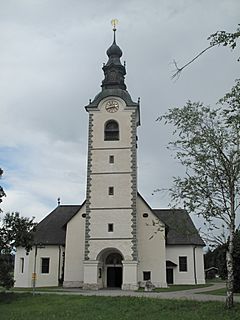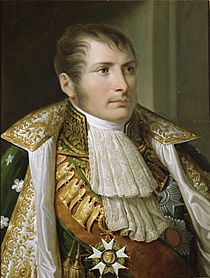Battle of Feistritz facts for kids
Quick facts for kids Battle of Feistritz |
|||||||
|---|---|---|---|---|---|---|---|
| Part of the War of the Sixth Coalition | |||||||
 View from Schloss Hollenburg toward the south bank of the Drava at Kirschentheuer. The Austrian grenadiers crossed a bridge at this location to reinforce Vécsey. Feistritz is located 7 kilometers to the right (west) |
|||||||
|
|||||||
| Belligerents | |||||||
| Commanders and leaders | |||||||
| Strength | |||||||
| 15,186 28 guns |
3,300 8 guns |
||||||
| Casualties and losses | |||||||
| 360 killed, wounded or captured | 913 killed, wounded or captured | ||||||
The Battle of Feistritz happened on 6 September 1813. It was a fight between a French army led by Paul Grenier and an Austrian army led by August von Vécsey. The French and their Italian allies won this battle.
This battle was part of the War of the Sixth Coalition, which was a bigger conflict during the Napoleonic Wars. The town of Feistritz im Rosental is in southern Austria, near the Drava River. At that time, it was close to the Illyrian Provinces, which France controlled.
When the Austrian Empire and France started fighting, an Austrian army under Johann von Hiller attacked the Illyrian Provinces. The Austrians quickly gained ground in the south. However, in Carinthia, the French-Italian army, led by Eugène de Beauharnais, pushed back the Austrians from their first crossing point at Villach. When the Austrians made a new crossing at Feistritz, Eugène sent General Grenier to stop them. Even though the French won this small battle, Eugène's army eventually had to leave Illyria and retreat to Italy.
Contents
Why the Battle Happened: Armies Prepare for War
In 1812, many of France's best soldiers from the French Army of Italy went to fight in Russia. Only about 3,000 of them survived that tough campaign. To rebuild his army in 1813, Emperor Napoleon brought more soldiers from Italy to Germany.
Napoleon then told his stepson, Eugène de Beauharnais, to create a new army. This new army would defend the Kingdom of Italy. By May 1813, this army was growing. It included French and Italian soldiers, even some who were conscripts (people forced to join the army). Some soldiers even wore police uniforms because there wasn't enough military gear.
Meanwhile, the Austrian Empire also got ready for war. They expanded their army. One part of their army, called the Army of Inner Austria, was in Carinthia. This army was led by Feldzeugmeister Johann von Hiller. Hiller's army had about 35,000 soldiers and 120 cannons. Even though it was smaller than Eugène's army, it had experienced commanders.
The War Begins: Austrians Advance
On 12 August 1813, Austria declared war on France. This meant the Illyrian Provinces and the Kingdom of Italy became battle zones. General Hiller sent about 10,000 Austrian troops to capture towns like Karlovac and Novo Mesto. He then led the rest of his army across the Drava River at Villach.
At the start of August, Eugène had about 47,000 soldiers in Illyria. His main base was in Ljubljana. His army defended a line from Tarvisio in the north to Karlovac in the south.
Many Croats in Illyria had hoped French rule would bring good changes. But they were disappointed. So, when the Austrians arrived, many Croats rebelled against the French. This helped the Austrians take over more land. Many soldiers from Illyria also started leaving Eugène's army.
Hiller's troops began moving into Illyria on 16 August 1813. The Austrians quickly captured Karlovac and Novo Mesto. On 20 August, over 6,000 Austrians attacked Villach. There were fights for a week. On 24 August, a French group of 3,000 soldiers tried to cross a bridge at Villach but were pushed back. They lost 604 men, while the Austrians lost 251.
On 28 August, a larger French force attacked Villach. They managed to push the Austrians out of the town. The French lost 112 men, and the Austrians lost 167. During this fight, most of Villach burned down, and parts of the bridge were destroyed.
The Battle of Feistritz: A Fierce Fight
Since the French stopped him at Villach, Hiller looked for another place to cross the Drava River. He found a spot south of Klagenfurt, at Feistritz im Rosental. He sent troops across the river there in late August. Eugène thought this Austrian position was dangerous for his army's communication. So, he ordered General Paul Grenier to take two divisions and remove the Austrians from Feistritz.
Grenier marched with his two divisions, leaving another general to hold Tarvisio. The Italian Guard, a special unit, also moved to a nearby town.
Hiller knew the French were exploring the Feistritz area. So, on the morning of 6 September 1813, he sent two battalions of grenadiers (elite soldiers) to Schloss Hollenburg nearby. General Vécsey set up his brigade along the Bärenthal ravine. His right side was on the Drava River, and his left was on steep, wooded hills. The Austrians had eight cannons. Two more cannons were on the other side of the river, ready to fire on any attack.
Vécsey's brigade had about 3,300 men. They were positioned behind the Bärenthal ravine. But they also had strong points on the west side, like Feistritz Castle, Holy Cross Cemetery, and some small villages. The bridge over the ravine was blocked.
Grenier had a much larger force: 15,186 soldiers and 28 cannons. His army was divided into two divisions.
On the morning of 6 September, Grenier's troops started marching in three groups. One group moved into the hills overlooking Feistritz. Another group moved towards the hamlet of Suetschach and waited. The third group followed later.
Grenier planned for his soldiers to get to the east side of the Bärenthal ravine. He also ordered his troops to clear out the villages of Mittel- and Ober-Feistritz. This would let them fire on the Austrians across the ravine. Another French group was told to attack the Austrians from behind.
Fighting started around 10:00 AM and became a full battle by noon. The main attack began at 3:00 PM. The French attacked the Austrian left side and from the front. Vécsey quickly asked for help from Hollenburg. The French captured some Austrians who were retreating towards the castle.
A French battalion fought hard and was supported by others. The attack focused on the church, the cemetery, and a small fort on the west side of the ravine. French soldiers rushed the fort and defeated its defenders. Other French units threatened the church and villages. When Austrian soldiers saw their fort fall, they retreated from the church and cemetery into Feistritz Castle.
The French charged the castle, but the attack was difficult because of obstacles and heavy gunfire. After being pushed back several times, the French set the castle on fire. As soon as it caught fire, the 116 defenders surrendered.
Then, the French rushed the bridge, which was defended by Austrian soldiers. When the French took the bridge, Vécsey's men left their positions and started to retreat. Some French soldiers crossed the ravine and were attacked by Austrian cavalry, but they fought them off. By about 5:30 PM, in heavy rain, the French had taken the entire Feistritz position.
As the French chased them, Vécsey's men fought back near Hundsdorf. The French pushed them back to Sankt Johann im Rosental. Here, the Austrians fought against one of the French battalions that had come down from the hills. Later that afternoon, the two grenadier battalions arrived and helped cover the Austrian retreat. At 8:00 PM, the grenadiers stopped one last French attempt to cut off Vécsey's escape. That evening, Vécsey retreated to the north side of the Drava River at Hollenburg and destroyed the bridge.
What Happened After the Battle
The French lost 60 soldiers killed and 300 wounded. The Austrians reported 67 killed, 364 wounded, and 394 captured. The two grenadier battalions also lost 88 men. Most of the captured Austrians were from specific regiments.
Hiller knew how important his crossing point was, but he didn't send help to Vécsey's brigade quickly enough. The nearest reinforcements were a six-hour march away. With Feistritz now in French hands, Eugène could use the Loibl Pass to communicate between his forces. He hoped to attack Hiller's left side.
However, Eugène couldn't take advantage of his win because his forces faced several problems.
- On 7 September 1813, an Italian brigade was defeated by Austrians at Lippa. The Italians lost 104 killed and 200 captured.
- The next day, near Trzin, another Italian brigade was ambushed by Austrians. The Italian 3rd Line Infantry Regiment was routed, losing many men, two flags, and two cannons.
- On 11 September 1813, Austrians captured 100 soldiers in a raid at Mühlbach. This forced a French general to retreat.
- On the same day, Austrians and the British Royal Navy captured the port of Pula.
- On 13 September, Eugène himself led the Italian Guard against Austrians at Šmarje–Sap. The Italian Guard was pushed back, losing 300 killed and wounded.
- On 14 September, a large Italian force attacked Austrians at Jelšane. The Austrians held their ground until dark and caused many casualties to the attackers.
- Another defeat happened at Višnja Gora on 16 September. Austrian cavalry attacked an Italian Guard battalion, capturing 910 men and two cannons.
Two other big reasons forced Eugène to leave Illyria. First, an Austrian force moved west into the Tyrol, threatening Eugène's left side. Second, the Kingdom of Bavaria, a French ally, might switch sides. Eugène's wife was a Bavarian princess, and her father was the King of Bavaria. The king was under pressure to join the other side.
By the end of September, Eugène complained to Napoleon that soldiers were deserting (leaving the army) in large numbers. By 5 October 1813, the French-Italian army had to retreat to the Isonzo River, which was on the border of Italy.





